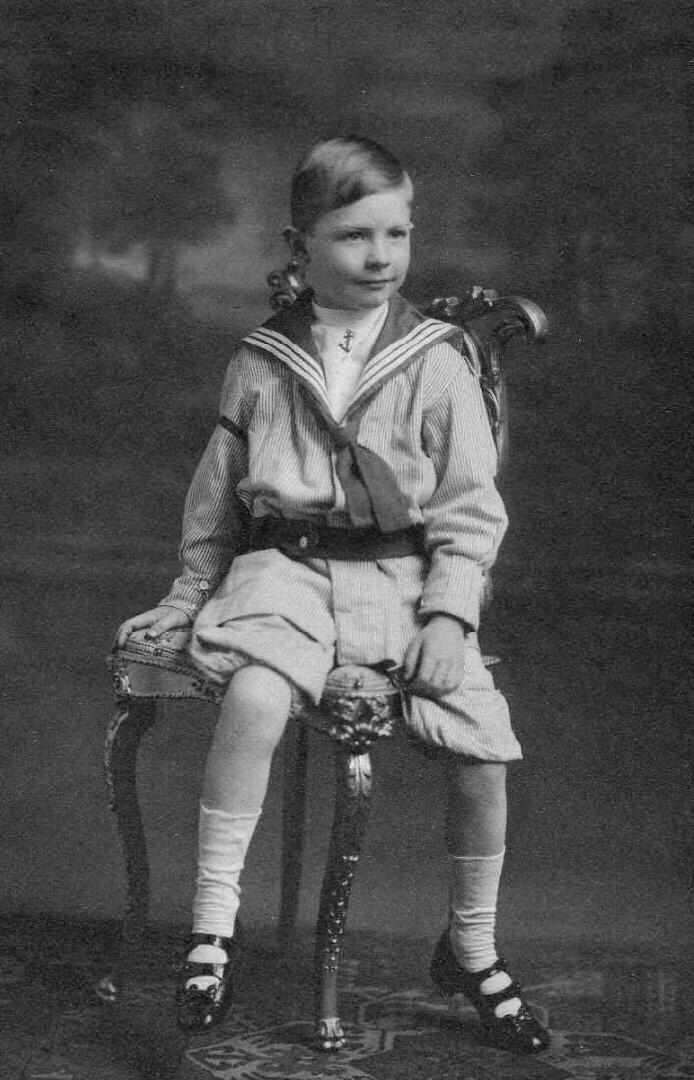
American Tunics: Social Class

Figure 1.--We believe that tunic suits were especially popular for boys from affluent families. We do not mean specifically rich families, but at least middle-classc families in comfortable circumstance. We know nothing aboput this boy. The immaculate grooming, white socks, and strap shoes all point to an affluent family. A portrait from a professional stufdio is another indication. Note the bows on the twin strap shoes. The portrait is undated, but the mount suggests the 1910s to us.
|
|
We see many boys wearing tunics in early- and mid-19th century. Our information on this early period is fairly limited. It looks to us, however, that tunics at this time were mostly worn by relatively affluent boys in towns and cities. Tunics styled somewhat differently were more also widely worn in America in the late-19th and early-20th century. This was especially true after the turn-of-the 20th century. We are not sure yet about the social class conventions. Our general assessment is that they were worn by a much wider wide cross section of American boys, but probably more commonly middle- and upper-class boys. This seems to be situation based on the portraits we have found. Of course it is difficult to know much about the family from unidntified portraits. Only rarely is detailed information available on the families involved. It is possible, however, to make assessments about social class based on the quality of the studio and the way the boys are dressed. The well grommed children and the background of snapshots suggest to us that tunics were much more for children from affluent families. There is no doubt that the emaculately dressed and groomed boy here came from an affluent family (figure 1). The shoes or sandals the boys are often wearing are also an indicator. Sandals and strap shoes were also more common with affluent families. For the first time, however, after the turn-of-the 20th century we see boys from more modest families commonly wearing tunic suits. The fact that it was an expensive outfit was probably a factor. Very few families, including working-class families, could not afford a tunic suit.
Indicators
It is difficult to know much about the family from unidntified portraits. Only rarely is detailed information available on the families involved. It is possible, however, to make assessments about social class based on the quality of the studio and the way the boys are dressed. The well grommed children and the background of snapshots suggest to us that tunics were much more for children from affluent families. Less well attired children and shoddy studio sets suggest children from more modest families
19th Century Trends
We see many boys wearing tunics in early- and mid-19th century. Our information on this early period is fairly limited (1800s-30s). It looks to us, however, that tunics at this time were mostly worn by relatively affluent boys in towns and cities. Without photography or with limited photographic iages (1840s-50s). it is difficult to make assessments. With the advent of the CDV (1860s) we are ablke to tell much more.
Tunics styled somewhat differently were more also widely worn in America in the very late-19th and early-20th century. This was especially true after the turn-of-the 20th century. We are not sure yet about the social class conventions. Our general assessment is that they were worn by a much wider wide cross section of American boys, but probably more commonly middle- and upper-class boys. This seems to be situation based on the portraits we have found. There is no doubt that the emaculately dressed and groomed boy here came from an affluent family (figure 1). The shoes or sandals the boys are often wearing are also an indicator. Sandals and strap shoes were also more common with affluent families. For the first time, however, after the turn-of-the 20th century we see boys from more modest families commonly wearing tunic suits. The fact that it was an expensive outfit was probably a factor. Very few families, including working-class families, could not afford a tunic suit.
HBC

Navigate the Boys' Historical Clothing Web Site:
[Return to the Main American tunic page]
[Return to the Main strap shoe page]
[Introduction]
[Activities]
[Biographies]
[Chronology]
[Clothing styles]
[Countries]
[Topics]
[Bibliographies]
[Contributions]
[FAQs]
[Glossaries]
[Images]
[Links]
[Registration]
[Tools]
[Boys' Clothing Home]
Created: 5:04 AM 7/7/2008
Last edited: 10:31 PM 5/7/2017



